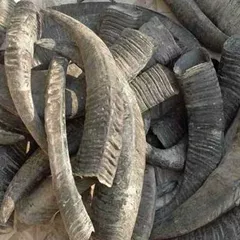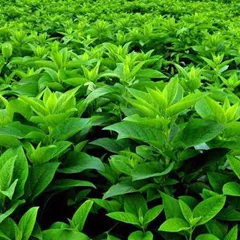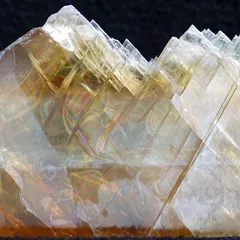Heat in the Blood
The information provided here is not a replacement for a doctor. You shouldn't use it for the purpose of self-diagnosing or self-medicating but rather so you can have a more informed discussion with a professional TCM practitioner.
At a glance
Preliminary reading: What is a pattern? The concept of Heat The concept of Blood
Key attributes
Chinese name: 血热 Pinyin name: Xuè Rè
Pattern nature: Full
Pattern hierarchy: General pattern with specific forms like Heat in Uterus Blood
Causes
Precursor patterns: Blood Stagnation Yin Deficiency Liver Fire Blazing and three other possible precursors
Common causes: 1. Emotional stress, 2. Diet, 3. External Heat
Diagnosis
Common symptoms: Thirst Bloody nose Bloody urine Bloody sputum Bloody stools and six other symptoms
Pulse type(s): Rapid (Shu)
Tongue description: Red tongue
Treatment
Treatment principle: Clear Heat from the Blood, nourish Yin, supply Body Fluids.
Common formulas: Xi Jiao Di Huang Tang Gu Jing Wan Shi Hui San and four other formulas
Pathology
The most common cause of Heat in the Blood is a Heat Pernicious Influence that has invaded the body and agitates the Blood. This results in accelerated blood flow which manifests itself in a rapid pulse, expanded and damaged Blood vessels and often heavy bleeding. The Blood will be fresh red or dark colored.
Note that bleeding episodes aren't always a sign of Blood Heat: it can also be caused by the Qi unable to hold the Blood in its pathways. The Blood will be pale in this case, with prolonged bleeding and heavy loss of Blood.
Blood Stagnation can also cause Heat in the Blood and consequent bleeding. The Blood in this case will be very dark colored with clots.
As usual the symptoms differ somewhat based on which Organs are affected. The most commonly affected Organs for Heat in the Blood are the Heart, the Liver, the Uterus and the Intestines.
If the Heart is affected by Heat in the Blood, this will result in a range of emotional symptoms since Heart houses the Mind (Shen). In that case patients will feel anxious, restless and may suffer from insomnia.
If the Liver is most affected by Blood Heat, then symptoms will tend to be skin-related: patients will feel itchiness and will see read skin eruptions appear.
If Blood Heat affects the Uterus and the Penetrating Vessel, patients can suffer exceedingly heavy periods.
Lastly if Blood Heat affects the Intestines, there will be Blood in the stools.
Causes
Precursor patterns: Heat in the Blood can derive from Blood Stagnation Yin Deficiency Liver Fire Blazing Heat in Pericardium Kidneys And Heart Not Harmonized Kidney and Lung Yin Deficiency
Emotional stress: Long term emotional stress such as anger, frustration and resentment, or a sudden emotional upset can lead to Liver Qi stagnation. It can agitate the Blood and cause excessive Heat in the Blood.
Diet: Excessive consumption of spicy & hot food or alcohol can cause this pattern.
External Heat: Overexposure to hot environment can also cause Heat in the Blood.
Diagnosing Heat in the Blood
Diagnosing a pattern in Chinese Medicine is no easy feat and should be left to professional practitioners. In particular one has to know how to differentiate between different types of pulses and tongue coatings, shapes and colors as well as learn to read from a long list of seemingly unrelated symptoms.
Pulse type(s): Rapid (Shu)
Tongue description: Red tongue
Main symptoms: Thirst Bloody nose Bloody urine Bloody sputum Bloody stools Heavy periods Cough of blood Feeling of heat Vomiting of blood Red skin eruptions Frequent bleeding episodes
Diagnosis commentary: Key characteristic symptoms of this pattern are the feeling of feat, red skin eruptions, thirst and Blood in stools, urine, sputum and etc.
Treating Heat in the Blood
Treatment principle
Clear Heat from the Blood, nourish Yin, supply Body Fluids.
Herbal formulas used to treat Heat in the Blood



The top herbs in Xi Jiao Di Huang Tang are Water Buffalo Horns (Shui Niu Jiao), Unprepared Rehmannia (Di Huang) and Red Peony Roots (Chi Shao)
Xi Jiao Di Huang Tang
Source date: 650 AD
Number of ingredients: 4 herbs
Key actions: Treats severe fevers and Heat in the Blood system. Removes Blood Stagnation.
Formula summary
Xi Jiao Di Huang Tang is a 4-ingredient Chinese Medicine formula. Invented in 650 AD, it belongs to the category of formulas that clear nutritive-level Heat.
Besides Heat in the Blood, Xi Jiao Di Huang Tang is also used to treat Heat victorious agitating Blood or Loss of Blood.



The top herbs in Qing Ying Tang are Water Buffalo Horns (Shui Niu Jiao), Ningpo Figwort Roots (Xuan Shen) and Unprepared Rehmannia (Di Huang)
Qing Ying Tang
Source date: 1798 AD
Number of ingredients: 9 herbs
Key actions: Clears the Nutritive level Heat. Relieves Fire Toxin. Removes Heat. Nourishes Yin.
Formula summary
Qing Ying Tang is a 9-ingredient Chinese Medicine formula. Invented in 1798 AD, it belongs to the category of formulas that clear nutritive-level Heat.
Besides Heat in the Blood, Qing Ying Tang is also used to treat Heat in Pericardium or Heat in Nutritive Qi level.



The top herbs in Gu Jing Wan are Tortoise Plastrons (Gui Ban), White Peony Roots (Bai Shao) and Baikal Skullcap Roots (Huang Qin)
Gu Jing Wan
Source date: 1481 AD
Number of ingredients: 6 herbs
Key actions: Nourishes Yin . Clears Heat. Stops bleeding. Stabilizes the menses.
Formula summary
Gu Jing Wan is a 6-ingredient Chinese Medicine formula. Invented in 1481 AD, it belongs to the category of formulas that secure irregular uterine bleeding and stop vaginal discharge.
Besides Heat in the Blood, Gu Jing Wan is also used to treat Heat in Uterus Blood.



The top herbs in Bai He Di Huang Tang are Lily Bulbs (Bai He) and Unprepared Rehmannia (Di Huang)
Bai He Di Huang Tang
Source date: 220 AD
Number of ingredients: 2 herbs
Key actions: Moistens the Lungs. Enriches the Body Fluids. Clears Heat and cools the Blood .
Formula summary
Bai He Di Huang Tang is a 2-ingredient Chinese Medicine formula. Invented in 220 AD, it belongs to the category of formulas that clear Heat from Deficiency.
Besides Heat in the Blood, Bai He Di Huang Tang is also used to treat Heat in Nutritive Qi level.



The top herbs in Hua Ban Tang are Gypsum (Shi Gao), Ningpo Figwort Roots (Xuan Shen) and Water Buffalo Horns (Shui Niu Jiao)
Hua Ban Tang
Source date: 1798 AD
Number of ingredients: 6 herbs
Key actions: Clears Qi-level Heat. Cools the Blood.
Formula summary
Hua Ban Tang is a 6-ingredient Chinese Medicine formula. Invented in 1798 AD, it belongs to the category of formulas that clear Heat from Qi and Blood.
Besides Heat in the Blood, Hua Ban Tang is also used to treat Stomach Heat or Fire.



The top herbs in Qing Re Gu Jing Tang are Baikal Skullcap Roots (Huang Qin), Unprepared Rehmannia (Di Huang) and Goji Tree Root Bark (Di Gu Pi)
Qing Re Gu Jing Tang
Source date: 1988
Number of ingredients: 11 herbs
Key actions: Clears Empty Heat. Tonifies the Kidney Yin. Stops bleeding. Supplies Body Fluids.
Formula summary
Qing Re Gu Jing Tang is a 11-ingredient Chinese Medicine formula. Invented in 1988, it belongs to the category of formulas that clear Heat from Deficiency.
Besides Heat in the Blood, Qing Re Gu Jing Tang is also used to treat Heat in Uterus Blood.



The top herbs in Shi Hui San are Japanese Thistle (Da Ji), Field Thistles (Xiao Ji) and Lotus Leaves (He Ye)
Shi Hui San
Source date: 1348g
Number of ingredients: 10 herbs
Key actions: Cools the Blood and . Stops bleeding. Clears Heat and drains Fire.
Formula summary
Shi Hui San is a 10-ingredient Chinese Medicine formula. Invented in 1348g, it belongs to the category of formulas that stop bleeding.
Related conditions
Please keep in mind that a Western Medicine condition can be caused by several Chinese Medicine patterns of disharmony and vice versa. As such a patient suffering from one of the conditions below will not necessarily be suffering from Heat in the Blood, it is just one pattern that's commonly associated with the condition. Click on a condition to learn what other patterns it's associated with.
Abnormal uterine bleeding Early menstruation Hepatitis Allergic purpura Acute leukemia Uremia Hepatic coma Septicemia Boils Acute hemorrhages
Special highlight: the link between early menstruation and Heat in the Blood

Goji Tree Root Bark (Di Gu Pi) is the key herb for Qing Jing San, a formula used for early menstruation caused by Heat in the Blood
Typical symptoms for early menstruation caused by Heat in the Blood: Anxiety Red face Tinnitus Dizziness Dark Urine Dry stools Dry throat Malar flush Restlessness Irritability Night sweats Early periods Heavy periods Abdominal pain Scanty periods Dark colored blood Bitter taste in the mouth Dark clots in menstrual blood Pre-menstrual breast distention
Recommended herbal formulas: Qing Jing San, Long Dan Xie Gan Tang, Jia Wei Xiao Yao San, Liang Di Tang, Di Gu Pi Yin
When early menstruation is caused by Heat in the Blood, the excessive Heat agitates the Blood and it leaks out of the vessels and therefore, periods come before the right time. There are two types of Blood Heat: Full or Empty.
Full Heat in Blood has two sub-patterns: external 'Heat/Fire Evil invasion' or 'Stagnant Liver Qi turning into Fire".
For the first one, living or working in a hot environment may accumulate Heat in the body. Also, excessive amount of hot-spicy foods or alcohol can also...Read more about early menstruation
Special highlight: the link between abnormal uterine bleeding and Heat in the Blood

Goji Tree Root Bark (Di Gu Pi) is the key herb for Qing Jing San, a formula used for abnormal uterine bleeding caused by Heat in the Blood
Typical symptoms for abnormal uterine bleeding caused by Heat in the Blood: Thirst Red face Dark Urine Dry stools Malar flush Constipation Restlessness Heavy periods Scanty periods Feeling of heat Dark colored blood Pale color periods Thick menstrual blood Thin and watery periods Trickling blood after period Flooding suddenly before schedule
Recommended herbal formulas: Qing Jing San, Long Dan Xie Gan Tang, Liang Di Tang, Di Gu Pi Yin
There are two types of Heat in the Blood that cause abnormal uterine bleeding: Full or Empty. Full Heat in the Blood often derives from Liver Fire or an external Heat Evil invasion, while the Empty type is mainly due to a prolonged lack of Yin which is a naturally cooling, its absence therefore leading to Heat.
The typical symptoms of the Full Heat type are heavy menstruations as well as a dark or bright red blood color. It can lead to sudden flooding before the periods and/or a trickling of...Read more about abnormal uterine bleeding
Consequence patterns
The Heat can condense the Blood and make it stagnated.
This is an Excess case. The Heat makes the Blood reckless and leak out of the vessels. The Blood is fresh red or dark and the quantity is often profuse.
